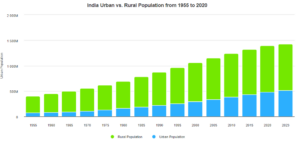
India must prioritise labour-intensive manufacturing to foster economic growth and employment, says the India Employment Report 2024. The report calls for urgent adoption of this strategy to absorb the millions of young individuals entering the workforce annually. Labour-intensive manufacturing not only provides immediate job opportunities but also lays the groundwork for sustainable economic development by enhancing skills and productivity of the workforce.
The advent of artificial intelligence (AI) and other technologies presents both a threat and opportunity for the Indian labour market. While these technologies threaten traditional jobs, particularly in sectors susceptible to automation, they also offer unprecedented opportunities for job creation in new and emerging industries. India’s vibrant startup ecosystem and digital infrastructure are well-positioned to leverage these opportunities, provided there is a concerted effort to align skills and education with the demands of a digital economy.
READ I India’s official unemployment figures miss the mark
Report questions job creation data
The report has challenged the government narrative on job creation in India. Using government data, it questions the claims of significant employment growth, especially those based on Employees’ Provident Fund Organisation data. Despite government assertions of creating 5.2 crore new jobs from FY20 to FY23, the report argues that these figures are inflated and misrepresent the true state of employment in India. It says a substantial portion of the EPFO figures represents the formalisation of existing jobs rather than the creation of new ones, with actual new job creation estimated at 2.27 crore for the period.
The EPFO data often includes contractual workers who become eligible for EPF due to regulatory mandates, rather than new employment. Moreover, the method of counting in EPFO’s payroll data, which includes new enrolments, re-joined members, and formalised employment, leads to an overestimation of actual job creation. The report suggests that the Indian labour market’s dynamics are more complex and that the government’s portrayal of robust employment growth is misleading, particularly in the context of formal sector job creation.
The report criticises the interpretation of Labour Force Participation Rate and Worker Population Ratio as indicators of economic recovery post-COVID. It argues that the increase in LFPR and WPR is primarily due to a rise in unpaid family labour, which should not be equated with formal employment. This misinterpretation has led to a narrative of falling unemployment rates, masking the actual economic distress.
Additionally, the report notes a significant shift of workers to agriculture during the COVID-19 pandemic, indicating a regression in the employment structure and underscoring the precarious nature of the job market. This shift, coupled with the decline in manufacturing employment, signals a troubling trend away from structured employment and economic diversification, challenging the government’s employment success narrative.
Why labour-intensive manufacturing
Despite the potential of India’s demographic dividend, the quality of employment available to its youth remains a concern. A large segment of young workers find themselves in precarious, informal, or underpaid roles, which do not fully utilise their skills or provide adequate security and growth opportunities. This issue is particularly acute in the informal sector, where a majority of Indian workers are employed. Addressing this challenge requires not only the creation of new jobs but also a focused effort to improve the standards and conditions of existing employment, ensuring that it aligns with the aspirations and potential of the young workforce.
The report, published by ILO and IHD, has recommended a series of measures to revitalise India’s labour market.
Focusing on labour-intensive manufacturing is essential for absorbing the surplus unskilled labour force. This approach should be complemented by nurturing modern manufacturing and service sectors that are employment-generative. Emphasis should be placed on MSMEs, which are crucial for decentralised and inclusive economic growth.
Exploiting the potential of environmental and marine resources can create vast employment opportunities in the green and blue economies. Strategic investments in these sectors, along with supportive policy measures, can stimulate job creation and contribute to sustainable development.
Developing rural infrastructure and integrating rural markets can rejuvenate the agricultural sector and stimulate non-farm employment. This approach can help reduce the rural-urban migration by providing viable employment opportunities in rural areas.
The rapid pace of technological change necessitates a strong focus on skill development and vocational training. Tailored training programs are needed to equip the workforce, especially in disadvantaged regions, with the skills required for the digital age.
Improving job quality, especially for young workers, is paramount. This involves not only creating more jobs but ensuring that these jobs are secure, well-paying, and conducive to long-term career development.
Median age in India is 28.2 years (2023)

India rural vs urban population from 1955 to 2020

The persistent rural-urban divide in employment opportunities is another aspect of India’s labour market. Rural areas, predominantly reliant on agriculture, have seen fluctuating employment trends, with many individuals shifting to urban centres in search of better opportunities. This migration, while contributing to urban economic growth, also stresses the urban infrastructure and creates challenges in urban employment generation. To counter this, there must be a balanced development strategy that enhances rural employment opportunities through agricultural modernisation and the promotion of rural industries, thereby reducing the excessive migration pressures on urban areas.
Policy directions for a transformative agenda
To realise this transformative vision for India’s labour market, the government needs to adopt a multi-pronged policy approach. It must integrate employment objectives with macroeconomic policies to stimulate growth in sectors that are capable of large-scale job creation. Policies should be designed to leverage digital technologies for job creation, while also addressing the risks of automation and job displacement.
A national strategy for skills and vocational training, aligned with the needs of the digital economy, is essential to prepare the workforce for future challenges. Enhancing the quality of education and training to meet the demands of a rapidly changing labour market is critical for long-term economic resilience.
The informal sector, employing a vast majority of India’s workforce, is often overlooked in formal economic planning. However, it is a critical component of the labour market, providing livelihoods to millions. Recognising the role of the informal sector and integrating it into the broader economic framework can unlock significant growth and employment potential. Policies should aim to formalise informal employment, ensuring social security, fair wages, and better working conditions, while also providing avenues for skill enhancement and upward mobility within this sector.
These strategies can help India address the challenges of youth employment and lay the foundation of an inclusive economy that leverages its demographic strengths and technological capabilities. A resilient labour market will need policies and collaborative efforts across all sectors of society. India can achieve a future where economic growth and employment opportunities are both abundant and accessible to all.
